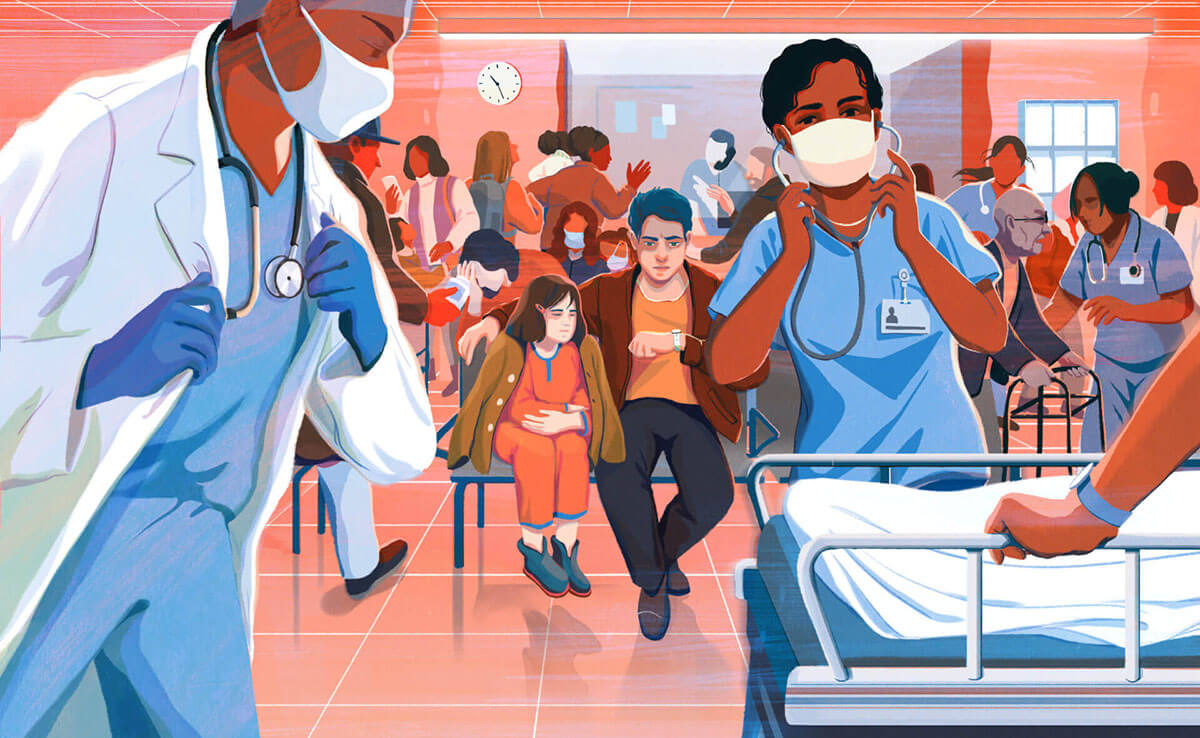
Illustration: Cornelia Li
A father and son rush to the emergency room late on a Friday night.
The son is writhing in pain – his ankle is mangled from a devastating hit on the football field. Triage nurses cut off the son’s cleats and assess his injury. The father cringes in horror. The nurses inform the father and son that they must wait before a doctor is available. So they wait. And wait. And wait.
In the American medical system, this happens all too frequently.
Investigative journalism publication ProPublica monitors ER wait times and found that California ER patients face a 5-hour, 34-minute wait before they are admitted to a hospital. Once receiving care, patients must navigate referrals to specialists, further delaying needed care. They also face overwhelming paperwork. In 2016, the Bloomberg Health Care Efficiency Index of 2016 ranked the United States 50th out of 55 countries for the performance of its healthcare systems.
Despite that less-than-stellar ranking, Americans pay the second most per capita in the world for healthcare, at $9,403 per person.
With this in mind, in 2021, the USC Viterbi School of Engineering’s Daniel J. Epstein Department of Industrial and Systems Engineering joined forces with the Keck School of Medicine of USC and the USC Sol Price School of Public Policy to pioneer a new master’s curriculum in health systems management and engineering. The HSME program works at the nexus of politics, medicine, business and engineering. A multidisciplinary program, the HSME master’s degree is the first of its kind on the West Coast.
David Belson, a USC Viterbi adjunct professor and a specialist in healthcare engineering, was key to developing the HSME program’s curriculum. As a hospital consultant for nearly two decades, Belson witnessed the inefficiencies of the American healthcare system firsthand. He noticed that hospitals often overstaffed personnel in areas where they were not needed, understaffed staff in areas where they were needed and suffered delays in care due to poor layouts.
“Healthcare in the United States is terribly inefficient,” Belson said. “Studies have demonstrated that nearly a third of all healthcare costs are wasteful. If we can reduce the cost of healthcare, it’s better for everybody.”
Belson teaches ISE 509, Practicum in Health Care Systems. He also collaborates with local hospitals and emergency departments to identify their needs. Afterwards, Belson formulates a list of projects that groups of students can choose to undertake. Groups must then apply their skills of optimization to work within hospitals to address inefficiencies.
Two of his students, Alissa Maier and Yuan Luo, are leading particularly interesting projects.

Alissa Maier (Photo/Courtesy of Alissa Maier)
Maier, a graduate student in the Health System Management Engineering program with over 10 years of field experience in healthcare, is developing a simulation using a prefabricated model to understand patient flows and wait times at the Los Angeles General Medical Center. While hospitals are required to track information such as wait times and throughput data, they are not readily equipped to analyze the data to identify trends and opportunities to improve, she said. Maier aims to input this and other data into a simulation model that will enable L.A. General administrators to identify opportunities to optimize their current staffing resources.
Such a simulation will enable hospital administrators to more efficiently allocate staff resources. For example, the simulation allows administrators to test moving staffing resources around and seeing how it effects wait times and efficiencies without the potential risk to patient care.
Maier’s inspiration to undertake her project comes from her personal experience in healthcare working at the USC Gehr Family Center for Health Systems Science and Innovation.
“Working in healthcare for years, I found we just need to work smarter,” Maier said. “I felt most drawn to the Health Systems Management Engineering program because it addresses the problems facing healthcare in a different way so that we can give patients more timely, safe and cost-effective care.”

Yuan Luo (Photo/Courtesy of Yuan Luo)
Luo, a graduate student majoring in analytics in the ISE department, worked with the Los Angeles General Medical Center as part of Belson’s ISE 509 class. Using data provided by the hospital, Luo, along with fellow graduate student Carolina Vallejo, aimed to create dashboards for various event types reported to the safety department, such as fall, skin integrity, behavioral event, care coordination/communication and adverse reaction to detect trends and help prevent avoidable incidents.
In undertaking this project, Luo encountered several obstacles in data analysis. The existing system lacked a concise event type list, and healthcare workers relied on their own understanding to select event types. As a result, the dataset became inaccurate. To tackle this problem, Luo and the HSME student team devised a new hierarchy of event types, enabling more precise categorization. This development effectively streamlined the process of entering and interpreting incident-related data, leading to a more effective system.
Furthermore, Luo noticed a cognitive laziness in selecting the “Other/Miscellaneous” event type when filing reports. Approximately 17% of event types fell into this ambiguous category, contributing to disorganized and uninformative data for trend identification. To rectify this, Luo implemented text classification, a machine learning technique that assigns predefined categories or labels to unstructured text data. This enabled the accurate reclassification of data previously listed as “Other/Miscellaneous” into more specific event types.
Once Luo and the team diligently parsed through the data, they could finally create a cohesive dashboard, capable of identifying hazards and optimizing patient care using Tableau software.
Belson is excited about the potential applications of Luo’s project.
“This tool could be useful at any hospital to better manage safety and quality,” he said. “It’s a really marvelous opportunity.”
Published on June 6th, 2023
Last updated on November 27th, 2024













